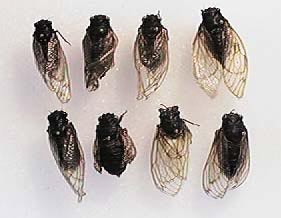John Cooley, a biologist at the University of Connecticut says it is not the lawn chemicals doing the damage, although humans are the ultimate culprit.
When cicada nymphs emerge, they must find something vertical to climb and stake out perching places to molt. At its perch, each cicada slips out of its nymph shell and then must hang undisturbed on that perch until its new exoskeleton unfolds and begins to harden properly. If it is disturbed during that time, its exoskeleton will be deformed ("faulty ecdysis," to the scientists).
In regular woody settings, there are plenty of trees, shrubs and tall grasses to support the cicada population. But here in the suburbs, yards are carefully landscaped, with neatly trimmed lawns and a few strategically placed trees and bushes, which limits the number of perches for the nymphs to hang on.
Since many cicadas must crawl onto the same places, they often bump into or climb over each other. This is a problem for those light-colored, recently molted cicadas who are waiting for their exoskeletons to harden. At the delicate stage when they must hang undisturbed, they are finding themselves trampled by other cicadas. This causes the many deformed cicadas.
The University of Connecticut Dept. of Ecology agrees, "Cicadas sometimes fail to properly inflate their wings after molting; such individuals can be found in low vegetation in any emergence.... The cicadas in the picture below came from a 1990 emergence in a suburban front yard near Chicago. Many of the cicadas in this area had deformed wings. Possible explanations include crowding (during molting) and use of lawn chemicals."
A University of Illinois entomologist believes it is normal to have so many deformed cicadas, although normally predators would eat them before we would see them. However, with these cicadas, there are so many insects, the predators can't keep up! (Chicago Cicada Central)
No comments:
Post a Comment